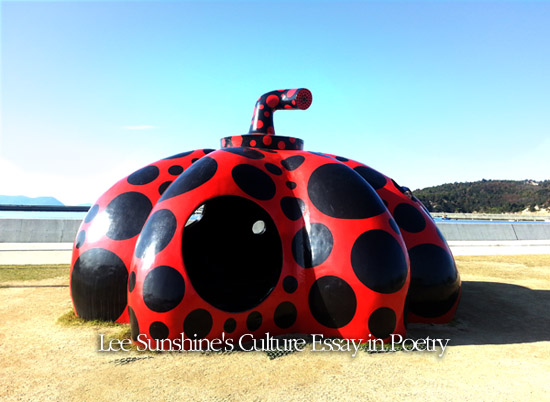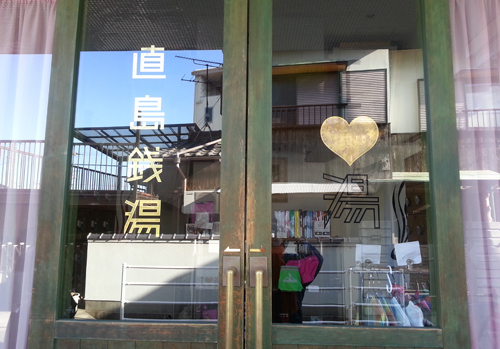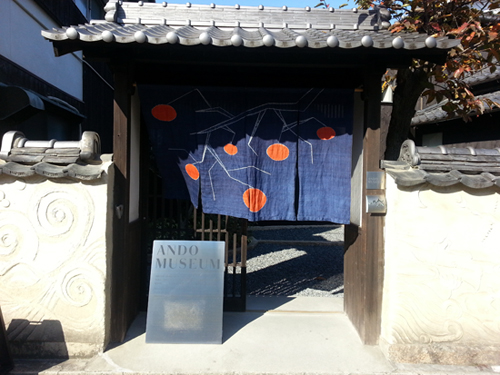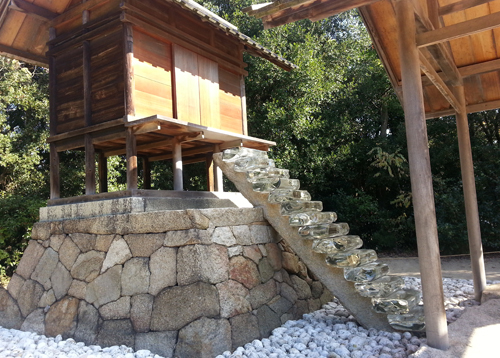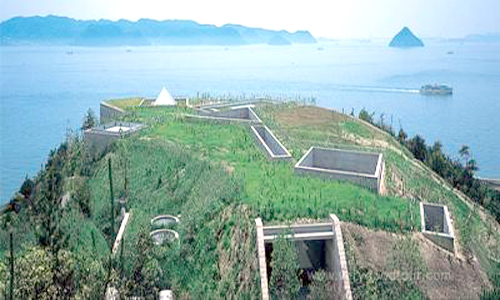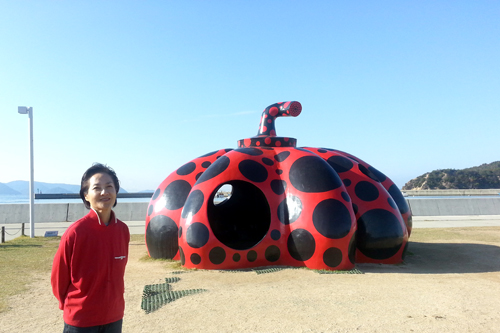Dec 8, 2014
The Sky in Naoshima
No disappointment for Naoshima, which is known for an island museum An island of Shikoku (formerly ‘Sanuki’), Japan. I have read articles, columns and watched images showing that numerous global tourists visit Naoshima where used to be the dead village, thanks to establishment of museums under the earth and a house project by an architect. Recently, I had an opportunity to visit Naoshima upon receipt of subsidy from Kagawa Ken. I felt warmer in Naoshima than in Seoul but residents there walked with hurried steps saying that the weather is suddenly colder. This was a first visit to Shikoku but I had an impression that it is similar to the southern part of Korea, not a foreign country, because flying hours is so short and the scenery is familiar to me. I first heard about the name Tadao Ando, who became the legend of Japanese architecture when I had frequently visited the National Gallery of Art in downtown of Washington, U.S. in the seventies. At that time I heard about I M Pei who is a world famous Chinese-born architect and that Tadao Ando who taught Architecture then at Harvard University. After a while, more than 10 years ago, I have seen an architecture exhibition by Tadao Ando at the National Museum of Contemporary Art, Korea (Gwacheon). It gave me a refreshing shock. I could catch his unique philosophy. Most of all, it was interesting. I could not buy a ticket for his lecture held in Seoul because all tickets were sold out even though they were expensive. Whenever I go to Osaka where his office is located in, I have tried to visit the Church of the Light and the Water Temple which made him famous. But due to time constraints, I could not manage the schedule and had delayed the visit. Finally I have not been there yet. I always see the buildings having walls imitating those created by him, that is, walls made of cements, having dents which size is as small as coins, everywhere in Korea. I have seen his work in Jeju Island and watched him saying that the number of on-going projects in China is about sixty, from NHK TV program. But I have never met him yet. When he was young, he had suffered from economic difficulties and become a boxer. Without entering a college, he had spent some years travelling alone and appreciating architecture in Europe. Later he had overcome the difficulties and become a world-famous architect winning Fritzker Architecture Prize. Japanese people cheered for his life and hungry spirit and he is also well-known in China and Korea. On the coast of Takamatzu, there are thousands of islands including deserted islands. When I arrived on Naoshima, one of the islands, after sailing by boat for one hour, the large steel pumkin by Yayoi Kusama greeted me. Naoshima had been a deserted village because residents who lost their jobs left it. Soichiro Fukudake, the president of Benesse Holding Inc., a Japanese education group, whose hometown is Okayama, which is near Naoshima, bought lands of Naoshima and established Benesse House Museum working with Tadao Ando 22 years ago. Thereafter, 10 years ago, he established Chichu Art Museum, which was constructed underground, displaying works by Claude Monet, James Turrell and Walter De Maria. In 2010 Lee Ufan Museum was constructed. The museum is named after Korean artist, Le Ufan. By attaching ‘I LOVE YOU’ on the glass door of the public bath house, it has become an art facility. In Japanese, ‘YOU’ means bath and boiling water. In reality, people can take a bath in the bath which has become the art facility. By comparison with the Korean bath employing a professional scrubber, used by Japanese tourists, the way of thinking is different. When I stood in line and entered empty houses, I was terrified due to its perfect darkness. But my eyes were soon familiar with the darkness four or five minutes later when I sat touching the walls with my hands. I walked through the dark purple light. That’s all. It is rather plain, but the feeling may be different depending on the person. Thanks to some light artworks by James Turrell, I realized that dead darkness and fear do not exist. It seemed likely that a sushi restaurant or a sanuki udong shop famous for its original taste may exist on the coast where we can see small islands in the distance. But, the silent sea where I could not find any signboard, architecture and artworks were in harmony, so it was excellent for people to meditate and think. In the city, I have taken the sky, which I sometimes looked up, granted. However, I felt different when I looked up the limited sky being seen as a circle through the ceiling from the underground, sitting on a stone round bench, which size is as big as the ceiling, and tilting my head back. There were many westerners, especially French people, who are from the country of art and seemed to have a connection with Japan. They were taking a rest looking up the blue sky and the floating white fluffy clouds as if they first saw. Every three years, the Setouchi International Art Festival is held on the neighboring twelve islands. It was only a two-day trip to Shodoshima and Naoshima, so I could not taste a bite of Sanuki udong, but there remained a restrained aftertaste.
It is said that Baekje, which had constructed numerous temples and houses, was collapsed and that Baekje people moved to and were settled in Aska, Osaka and Kyoto in order to avoid their death about 1,400 years ago. I thought that Tadao Ando may be a descendent of family An, who were Baekje artisans and constructed houses. Architecture is an amazing art changing the appearance of the earth. The architecture in Naoshima lied in the bare skin thereof.
The round sky As if I first saw I looked up the sky from underground
The sky looked down The art of Monet And me
Naoshima
Public bath house ‘I ♥ you’ (I ♥ 湯) – November 18, 2014
The Entrance of Ando Museum in Naoshima, Kagawa Ken - November 2014
The art facility, which glass steps of Minami Temple, which is extremely small connect to the underground tunnel
Chichu Art Museum, which is a masterwork by Tadao Ando in Naoshima – November 18, 2014 Steal pumpkin by Aayoi Kusama in Naoshima, Kagawa Ken – November 18. 2014
|

